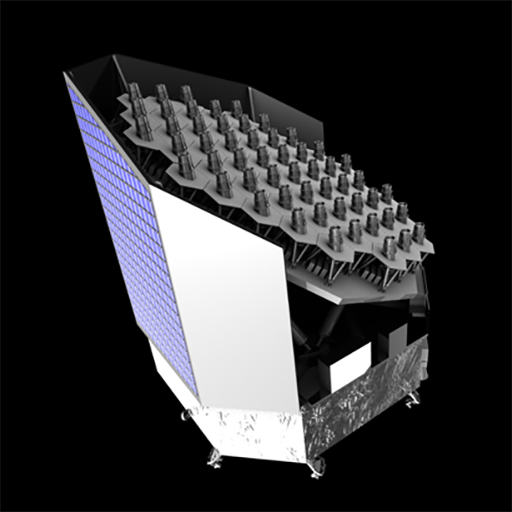5.2 PLAnetary Transits and Oscillations of stars – the PLATO mission
PLATO is a European Space Agency (ESA) mission that is due to launch in 2026. Like TESS, it’s a space telescope designed to search for transiting exoplanets, but the detail of what it’s going to be looking for is different.
In Week 4 you watched a video about SuperWASP, a collection of ground-based telescopes looking for transiting exoplanets. SuperWASP has been very successful at detecting hot Jupiters. PLATO is designed to be a bit like a space-based version of SuperWASP, having 26 separate cameras mounted on the spacecraft. Because it is space-based, it can make precise measurements of the brightness of stars, unaffected by the Earth’s atmosphere.
Activity 5 The transit depth equation
The radius of the Earth is about 1/100th of the radius of the Sun. Work out the depth of the transit of an Earth-like planet across a Sun-like star.
Hint: the transit depth equation was last mentioned in Week 7.
Answer
The transit depth is given by
So, if the size ratio Rp/Rstar is 1/100, the transit depth will be (1/100)2 or 0.0001, or 1/100th of 1 per cent. That’s roughly equivalent to trying to detect a tiny fly crawling across a car headlight several miles away!
The advantage of the multi-camera setup is that PLATO will be able to study a relatively large area of sky at any given time, and during the mission it will look at around 1 million stars. One of PLATO’s key goals is to find Earth-sized planets in the habitable zones of Sun-like stars, which involves observing planets with periods of around one year. It should find lots of small transiting planets, just like Kepler has. The big advantage is that the PLATO planets will be orbiting bright, nearby stars.
Therefore, in tandem with follow-up investigations from large current and future ground-based observatories, and from a new space telescope to be launched in the next few years, PLATO will help to address some pretty big questions. How do planetary systems form? How common are worlds like ours? And even, what conditions are needed for the emergence of life?
Apart from finding planets, PLATO will also be doing important work in helping us to gain a better understanding of the stars themselves. One of the things that makes spotting transits and radial velocity wobbles harder is that stars themselves undergo changes that can mimic signals caused by small planets.
Our Sun, and most other stars, have darker regions on their surfaces that come and go with time. These are called ‘starspots’ (or ‘sunspots’ in the case of the Sun). They can move slowly over the star’s surface, and they appear and disappear over a few weeks or months. Starspots can cover different parts and a different fraction of the star at different times. Our Sun has an 11-year cycle, in which it goes from its most spotty phase, which we call Solar Maximum, to its least spotty phase, or Solar Minimum.
Variation in these dark patches can change a star’s brightness over time, which can interfere with other measurements like transits. By studying stars in more detail with PLATO, astronomers will be able to understand these processes and other properties of stars better.
Watch this video, taken by a camera on NASA’s Solar Dynamics Observatory, which shows a cluster of sunspots moving over the surface of the Sun and changing shape.
Activity 6 PLATO
Why is it so important that PLATO is able to detect planets with periods of around one year?
Answer
PLATO being able to detect planets with periods of around a year means that it is possible to detect Earth twins – Earth-sized planets in the habitable zones of Sun-like stars.
To be able to detect dips in brightness of one hundredth of one per cent, separated by a year, PLATO’s work to understand the small intrinsic variations in starlight will be vital. Like many worthwhile projects, the basic idea is simple and straightforward. The challenge is getting all the details right.

